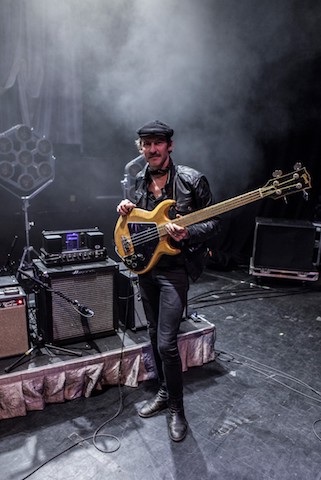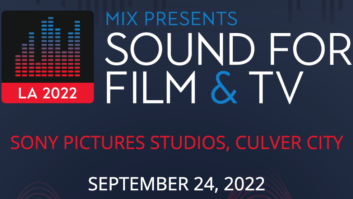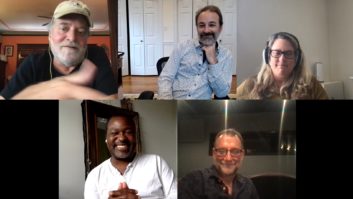
Denver, CO—May 2018… Since their mid teens in rural Hermann, Missouri, Joseph Pope III and Nathanial Rateliff have been friends and bandmates. Pope, a singer, songwriter, and multi-instrumentalist, mostly played guitar in their early collaborations but eventually gravitated toward the bass. Their current band, Nathaniel Rateliff and the Night Sweats, plays upbeat, soulful, partying music that recalls vintage R&B. Except for his very first bass rig, which wasn’t an Ampeg—“a combo amp I got from my high school and then proceeded to blow up,” he laughs—Pope has relied entirely on Ampeg bass amps.
Pope’s melodic approach to bass stems from his own musical trajectory. “My first instrument was trumpet, starting in sixth grade, and from playing trumpet, I got a strong sense of melody and ensemble playing. In bands with Nathaniel I originally played guitar, but I was never a very good lead player, so I moved over to the bass,” Pope explains. “For awhile my wife, Julie Davis, played upright bass so I moved over to guitar again but I kept coming back to bass. There’s something about the role you play as a bass player that speaks to me as a person. Nathaniel and I had a band years ago where a lot of my bass parts had guitar melodies built into them, more than a typical bass approach, and I think that works really well in the Night Sweats too. That’s how I like to approach bass, as opposed to playing the roots or playing slap bass.”
Low on funds, yarns Pope, “I bought an old Ampeg V-4 off of Ebay. The V-4 came highly touted, and I still use it regularly. But when we were kids, we’d see bands play with Ampeg SVT amps and cabinets. We’d play so loud in my mom’s basement, we wanted our jeans to flap from the air coming off the speakers. So for our band Born in the Flood, the first thing I did was go out and buy an Ampeg SVT Classic with an SVT-810 cabinet. I loved it, the feeling of standing in front of that thing was great. But of course I kept my V-4 as well.”
Pope was sold on the Ampeg sound but Born in the Flood was mostly playing in small clubs, and as much as he loved the SVT, it was too much for those gigs. “Our good buddy Xandy Whitsel was the front-of-house sound guy at this little club in Denver called the Hi-Dive,” he remembers, “and he told me, ‘it’s cool to have eight speakers but you know I can only mic one of those, right?’ It was a good point, and I thought about that over the years: The stage feel is one thing, and the way it actually sounds at front-of-house is another.”
Thus began Pope’s odyssey in search of the perfect Ampeg rig for his gigs. “I came across an Ampeg B-15 in a studio in Chicago, and it had an unmistakable sound,” Pope recalls. “Having heard that, I decided to go with the Ampeg PF series. I found a PF-210 that I liked, so I bought that, and I bought a ‘67 Ampeg B-15 Portaflex head to go with it because I really dug those mid-late ‘60s Ampeg amps. I also got a SVT-212 cabinet to go with my V-4B. So I was chaining the V-4B and two 12s with the B-15 Portaflex and two 10s. The B-15 wasn’t as powerful as the V-4b but it had the tone I wanted for front-of-house, and I was using the V-4B for stage volume, to feel it in the body, get those pants flapping again.”
But Pope wasn’t done yet. He still wanted a PF-115 cabinet to put underneath the PF-210 cabinet in order to complete his B-15 rig. Then, while on the road, Pope found the Ampeg cabinet he had been seeking. “I was in a repair shop in a strip mall, very unassuming but very legit,” he relates. “They had a bunch of old cabinets and amps, including a 1972 B-15 cabinet that didn’t have a head. So I came back to soundcheck with the cabinet, and I stacked the B-15 amp and cabinet on top of the PF-210 cabinet, next to the V-4 and PF-212. The guitar players were playing through small amps, and they were like, ‘You SOB, we’re going to get more amps and go for it!’”
For Pope, there’s just nothing like the B-15 sound. “Nathaniel and I were talking about the tone of the old doo-wop and soul records,” he muses. “We’re trying to find that round tone, to get that James Jamerson/Carol Kaye kind of thing going. The secret weapon that we discovered is flat-wound bass strings through an Ampeg B-15. I don’t know how to get any closer to the tone I heard on those great old sessions than playing flat-wounds through a B-15.”







